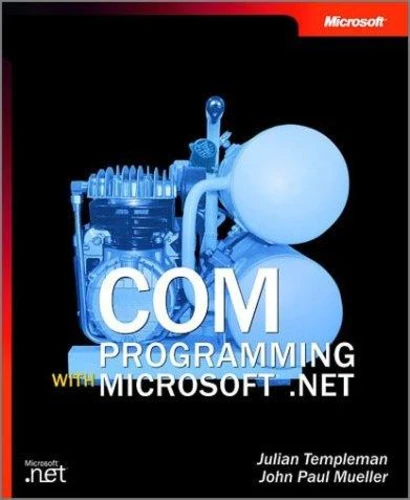COM Programming with Microsoft. Net
Par :Formats :
Définitivement indisponible
Cet article ne peut plus être commandé sur notre site (ouvrage épuisé ou plus commercialisé). Il se peut néanmoins que l'éditeur imprime une nouvelle édition de cet ouvrage à l'avenir. Nous vous invitons donc à revenir périodiquement sur notre site.
Disponible dans votre compte client Decitre ou Furet du Nord dès validation de votre commande. Le format Multi-format est :
- Pour les liseuses autres que Vivlio, vous devez utiliser le logiciel Adobe Digital Edition. Non compatible avec la lecture sur les liseuses Kindle, Remarkable et Sony
 , qui est-ce ?
, qui est-ce ?Notre partenaire de plateforme de lecture numérique où vous retrouverez l'ensemble de vos ebooks gratuitement
Pour en savoir plus sur nos ebooks, consultez notre aide en ligne ici
- Nombre de pages544
- FormatMulti-format
- ISBN0-7356-3017-8
- EAN9780735630178
- Date de parution15/02/2003
- Protection num.NC
- Infos supplémentairesMulti-format incluant PDF sans p...
- ÉditeurMicrosoft Press
Résumé
Microsoft . NET is here, but COM and COM+ will be a valuable part of every Microsoft Windows®programmer's toolbox for years. This in-depth programming guide explains how and where COM and COM+ fit into the new . NET world, demonstrates the new technologies that are available in . NET, and shows how to interoperate between COM/COM+ and . NET. It explains how to use Microsoft Visual Studio®. NET to write traditional COM objects, how to use COM objects in .
NET code, and how to use . NET objects as COM objects. It also discusses COM+ topics such as disconnected applications and subscriptions. The authors show you both theoretical and practical approaches-explaining how the mechanisms work and also providing practical advice with sample code to show how to handle interoperability. Topics covered include: The . NET view of COM and COM+ - COM, COM+, and .
NET - Using COM components in . NET code - Using . NET components in COM applications - Overview of COM+ coding for . NET Writing COM code - Attributed programming - Active Template Library (ATL) and ATL Server Writing COM+ code - A simple COM+ example - Working with disconnected applications - Creating subscriptions - Web application scenarios Interoperability - Interacting with unmanaged code - Advanced interaction - Working with predefined interfaces Includes sample code on the Web
NET code, and how to use . NET objects as COM objects. It also discusses COM+ topics such as disconnected applications and subscriptions. The authors show you both theoretical and practical approaches-explaining how the mechanisms work and also providing practical advice with sample code to show how to handle interoperability. Topics covered include: The . NET view of COM and COM+ - COM, COM+, and .
NET - Using COM components in . NET code - Using . NET components in COM applications - Overview of COM+ coding for . NET Writing COM code - Attributed programming - Active Template Library (ATL) and ATL Server Writing COM+ code - A simple COM+ example - Working with disconnected applications - Creating subscriptions - Web application scenarios Interoperability - Interacting with unmanaged code - Advanced interaction - Working with predefined interfaces Includes sample code on the Web
Microsoft . NET is here, but COM and COM+ will be a valuable part of every Microsoft Windows®programmer's toolbox for years. This in-depth programming guide explains how and where COM and COM+ fit into the new . NET world, demonstrates the new technologies that are available in . NET, and shows how to interoperate between COM/COM+ and . NET. It explains how to use Microsoft Visual Studio®. NET to write traditional COM objects, how to use COM objects in .
NET code, and how to use . NET objects as COM objects. It also discusses COM+ topics such as disconnected applications and subscriptions. The authors show you both theoretical and practical approaches-explaining how the mechanisms work and also providing practical advice with sample code to show how to handle interoperability. Topics covered include: The . NET view of COM and COM+ - COM, COM+, and .
NET - Using COM components in . NET code - Using . NET components in COM applications - Overview of COM+ coding for . NET Writing COM code - Attributed programming - Active Template Library (ATL) and ATL Server Writing COM+ code - A simple COM+ example - Working with disconnected applications - Creating subscriptions - Web application scenarios Interoperability - Interacting with unmanaged code - Advanced interaction - Working with predefined interfaces Includes sample code on the Web
NET code, and how to use . NET objects as COM objects. It also discusses COM+ topics such as disconnected applications and subscriptions. The authors show you both theoretical and practical approaches-explaining how the mechanisms work and also providing practical advice with sample code to show how to handle interoperability. Topics covered include: The . NET view of COM and COM+ - COM, COM+, and .
NET - Using COM components in . NET code - Using . NET components in COM applications - Overview of COM+ coding for . NET Writing COM code - Attributed programming - Active Template Library (ATL) and ATL Server Writing COM+ code - A simple COM+ example - Working with disconnected applications - Creating subscriptions - Web application scenarios Interoperability - Interacting with unmanaged code - Advanced interaction - Working with predefined interfaces Includes sample code on the Web




